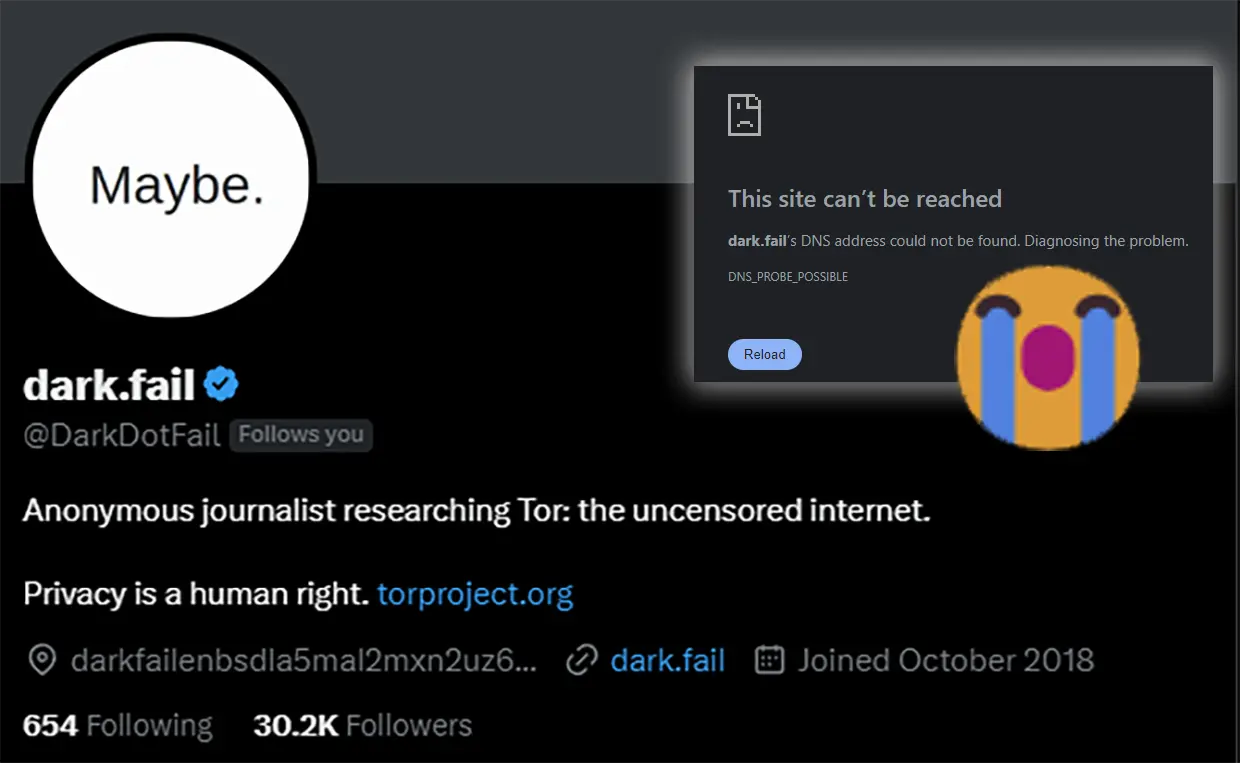

What is Dark.Fail, and who cares?
Dark.Fail has been a go-to spot for many in the Darknet/dark web community, acting like a directory or guide to what’s out there in the dark corners of the web. It’s an index site that lists various Darknet sites and shows a green dot if they are active. I have loved this site for years, as it’s easy to remember and has a cool name. When I was in federal prison, people used to ask, “How do I get started on the Darknet?” I used to refer to them to dread (more on that later; you need Tor to use that link), specifically dark.fail (Clearnet link, Tor Link)as a first step in the journey of exploration.
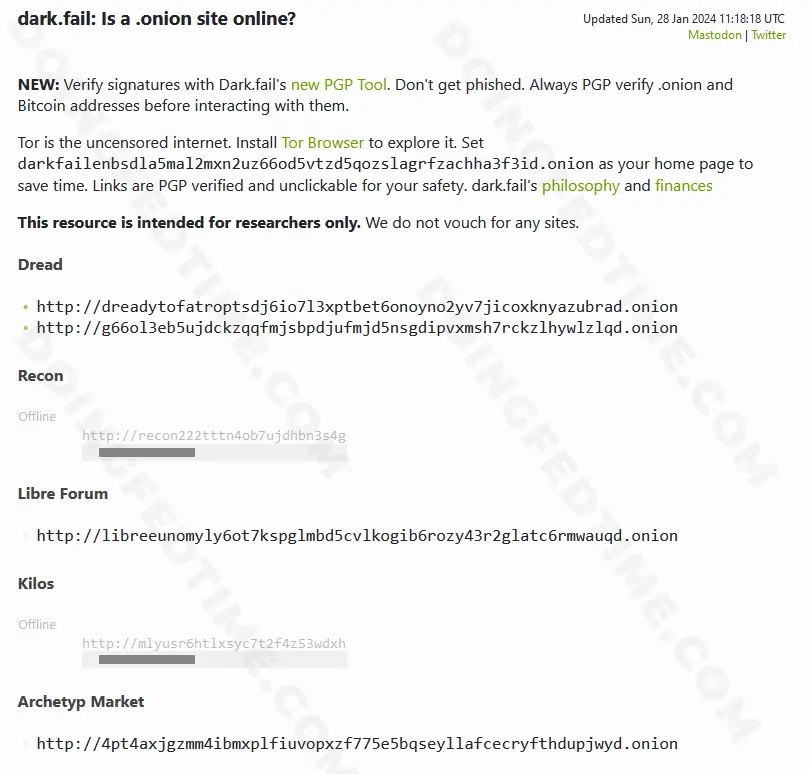
http://darkfailenbsdla5mal2mxn2uz66od5vtzd5qozslagrfzachha3f3id.onion/
Specifically the Darknet (which is different from the clearnet and the deepweb). Think of it as your friend who knows all the cool, hidden spots in town. But recently, this friend got laryngitis and cannot talk. The site went down, and it wasn’t just a minor hiccup.
Why is this a big deal? When a site like Dark.Fail, a roadmap to the Darknet goes offline; it’s like navigating a maze without a map. It got people thinking about how much they depend on these index sites and whether there’s a backup plan. This is where the decentralized alternatives come into play. These are like the back roads or secret passages that not everyone knows about, and they can be super helpful when the main roads are closed. So, the big question is, how reliable are these Darknet index sites, and what other options are out there when things go south?
Detailed Analysis of Dark.fail’s Outage
When Dark.Fail hit a snag, and the word spread fast, thanks to their Twitter account, @DarkDotFail. They put out the news that Cloudflare’s nameservers, which are the internet’s way of finding websites, weren’t playing ball with their domain. This was a big “uh-oh” moment for users who rely on Dark.They fail to find their way around the Darknet. The community’s reaction was a mix of surprise, annoyance, and nonsensical twitter/x spam about crypto.

Cloudflare is usually the behind-the-scenes hero that keeps sites like Dark.Fail up and running smoothly. But when Dark.Fail needed them the most; they were MIA. There was no word from Cloudflare, and when Dark.Fail checked their account; everything seemed fine on the surface. But with a support ticket saying, “Wait three days for a reply,” the frustration was real. It’s like calling for help and getting an answering machine instead. This silence from Cloudflare even got Dark.fail thinking about ditching them, worrying about whether this was some kind of censorship move.
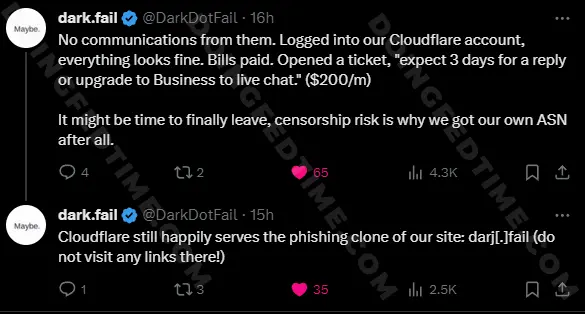
In all this chaos, there was a silver lining – Dark.Fail’s .onion ( You need the Tor Browser, or even better, Tails to use this link: http://darkfailenbsdla5mal2mxn2uz66od5vtzd5qozslagrfzachha3f3id.onion/ )domain on the Tor network was still up and running. This is where the difference between the regular internet (the clearnet or surface web and the deep web, which is the same thing, just not indexed by Google) and the Tor network (home of the Darknet/dark web) shines.
While the clearnet relies on centralized systems like DNS, which can have these hiccups, the Tor network is more like a bunch of back alleys that don’t depend on one main road to get you where you’re going. This decentralized approach means that even if the clearnet part of Dark.Fail was having a bad day; their .onion side was doing just fine, thanks to Tor’s way of doing things. It was a bit of a hat-tip to the Tor Project for keeping their part of the internet reliable when the usual paths weren’t.
Historical Context and Archival Importance of Dark.fail
Dark.Fail isn’t just another website that popped up overnight. It’s been around for a while, making its mark since way back in 2018. Think of it like an old tree in a park that’s seen many seasons change. Like a time machine for websites, the Wayback Machine has snapshots of Dark.Fail from August 9, 2018, to January 6, 2024. These records are vital because they’re like a digital scrapbook, showing how Dark.Fail has evolved. It’s not just about nostalgia; it’s about having a record in case things go south or someone tries to rewrite history.

Now, let’s talk about what Dark. fail does. Imagine it as a giant billboard that lists all sorts of hidden spots in the Darknet – from marketplaces to chat forums. But it’s not just the shady stuff; it also points to legit .onion links for mainstream services. This isn’t just a random list, though. Dark.Fail uses a PGP verification service to ensure these links are accurate. It’s like a bouncer checking IDs before letting anyone in.
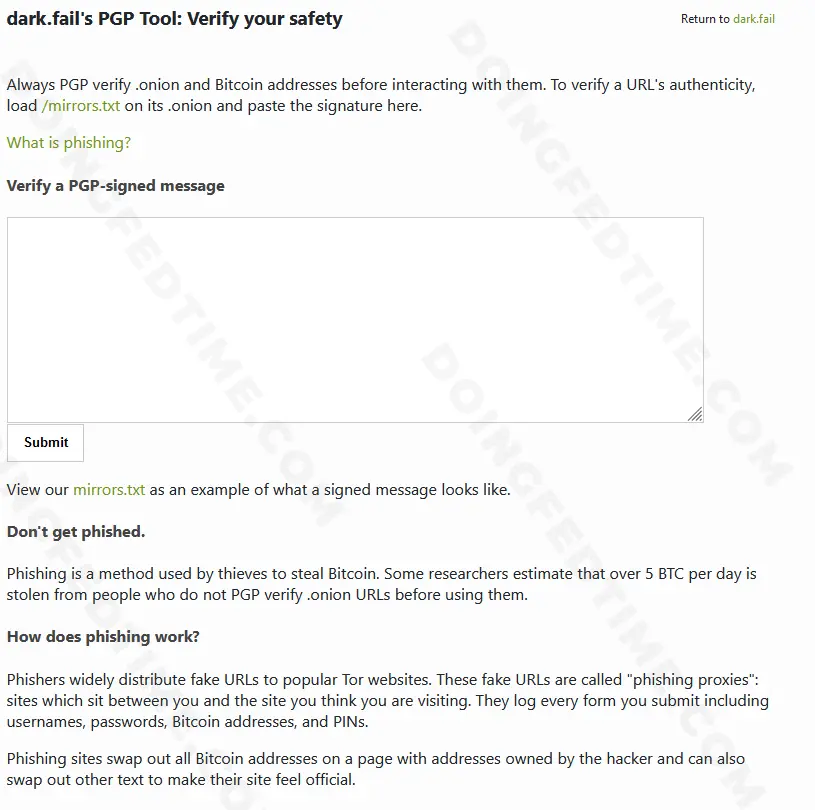
As someone who’s been using Dark.Fail for a while, I can tell you it’s been pretty solid. It’s like having a reliable guide in a maze, finding and using the working .onion link for Dark.Fail was like getting a VIP pass to the Darknet – a more secure and direct route to all the stuff listed there. It’s been a game-changer in navigating the Darknet safely and efficiently. I also loved not having to try it and figure out it was down after waiting a minute. Like many indexing sites dark.fail includes status links in the form of green dots to the left of the URL if it’s up.
The Necessity of Reliable Darknet Indexes
In the world of the Darknet, having a reliable index site is like having a sound GPS in a confusing city. It’s crucial. When Dark.Fail had its hiccup; it was a wake-up call about how much everyone in the Darknet world relies on these indexes. This is where alternatives like Daunt.Link (Clearnet Link, Tor Link)and Tor Taxi (Clearnet Link, Tor Link, I2P Link)You need Tor to use the come into the picture. Consider them alternative GPS apps when your usual one is acting up.

Daunt.Link and Tor Taxi aren’t just random choices; they’ve earned their stripes. HugBunter, a well-known name in these circles, set up both Dread (Tor Mirror 1, Tor Mirror 2)and Daunt.Link. Dread became a kind of Darknet Reddit, filling the gap when Reddit decided to cut ties with its Darknet and dark web sections.
Then came Daunt.Link follows in Dread’s footsteps but focuses more on being a reliable index. HugBunter saw a need for trustworthy signposts in the Darknet and stepped up to the plate.
However, it’s not all smooth sailing. Existing index sites face their fair share of challenges, mainly phishing attacks and fake sites. Phishing here is like someone setting up a fake signpost on the road, directing you to a dead-end instead of your destination. It’s a big problem because it exploits users’ trust in these indexes. That’s why having verified links is super important. It’s like having a way to check if the signpost is legit or just leading you into a trap. Verified links are crucial in keeping everyone’s trust in these indexes and ensuring the Darknet doesn’t turn into a wild goose chase.
Many times, these attacks could be from an index being hacked, but there have been times in the past where it’s just been that the site’s owner sells the site, and the new buyer of the site puts up fake links, and capitalizes on the trust earned, from the previous admin.
Dread, A Community Response to Censorship
Imagine Reddit decided to shut down all its edgy, underground sections one day. That’s precisely what happened with its Darknet and Darkweb sections. This left a big void.
Enter Dread.
Created by HugBunter, Dread filled this gap and became the go-to spot for all the discussions Reddit decided it didn’t want anymore. It’s like a virtual town square for the Darknet crowd – where you can chat about anything from marketplaces to Darknet OpSec without someone pulling the plug.
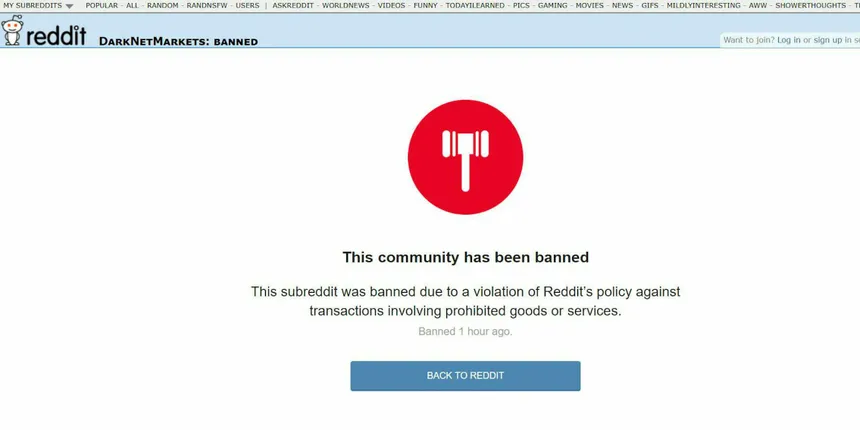
Dread is more than just a forum; it’s a community hub. It’s where people on the Darknet exchange ideas, help each other out and stay informed. Think of it as a bustling café in the digital underworld where everyone knows your alias, not your name. Unlike Darknet marketplace forums, the beauty is that you can talk badly about a Darknet market if you want to, and you will not be silenced.
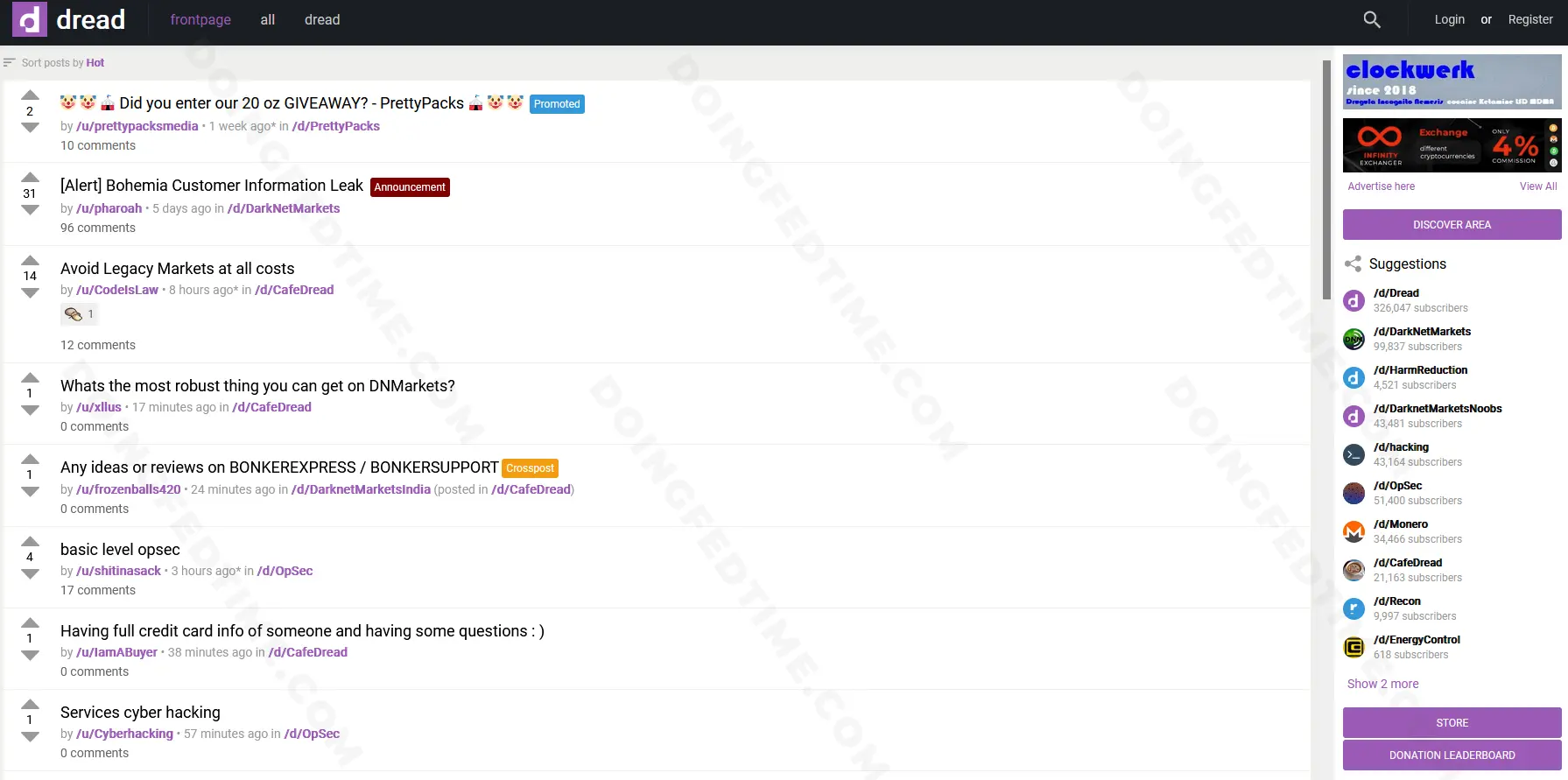
Daunt.Link’s – Philosophy and Mission
Now, let’s talk about Daunt.Link. This isn’t just another index site; it’s HugBunter’s brainchild, born from needing a trustworthy guide in the Darknet’s murky waters. After seeing more than a few index sites go wrong for the money, either directly or indirectly, Hugbunter decided to take action. After setting up Dread, HugBunter noticed a worrying trend: many index sites were either corrupted or trapped. It was a weak point that we didn’t see overexploited on the Darknet, like the manipulation of some other things (like DDoS attacks, etc).

Daunt.Link is his (or her, nobody knows) answer to this problem. It’s like a reliable compass in the Darknet, aiming to keep things straight in a world where it’s easy to get lost or tricked. HugBunter’s goal was simple but ambitious: create a place where people can find genuine, safe links without worrying about stumbling into a scam or a phishing site. It’s all about maintaining integrity in a space where trust is hard to earn and even harder to keep.
On Daunt, you will find various listings, not just Darknet markets. Also listed are forums, private Darknet vendor shops, and a miscellaneous section. In addition to that, you will find a FAQ section, and periodically, you may see some news in a banner.
Phishing: A Persistent Threat in the Darknet Landscape
Phishing in the darknet is like someone setting up a fake storefront in a busy market, tricking you into thinking it’s the real deal. It’s a big problem because it’s all about deceiving users into giving up their info or credentials, thinking they’re on a legit site. This can lead to all sorts of trouble, from stolen identities to lost crypto.


To fight this, the Darknet community has devised some clever strategies. One of the key moves is using PGP (Pretty Good Privacy) verification services. Sites like Dark.fail use this to check if the links they list are legit. It’s like having a secret handshake that only you and the genuine site know. This way, users can be sure they’re not entering a phishing trap.
The community’s trust in these indexes is huge. Reliable link indexes are like trusted guides in a dense forest; without them, it’s super easy to get lost or end up in a dangerous spot. That’s why these verified links are more than just convenience; they’re crucial to staying safe in the darknet.
Tor Taxi: A Diverse Darknet Directory
Tor Taxi isn’t your average directory. It’s like a Swiss Army knife for navigating the darknet, offering multiple ways to get around. It’s not just a list of links; it’s a multifaceted guide helping users find their way in the darknet world.

What makes Tor Taxi really stand out is its dual accessibility through both the Tor and I2P networks. Now, here’s where it gets interesting. While Tor is well-known for its onion routing, which anonymizes users by bouncing their communications over a distributed network, I2P (the Invisible Internet Project) operates a bit differently. I2P specializes in creating a secure and anonymous layer within the internet, providing a separate network for secure communication. It’s like having two different types of camouflage, each useful in its own environment. This dual-network or tri-network accessibility gives Tor Taxi a strategic edge, offering users more options to access information securely and anonymously.
Using Tor Taxi feels like navigating through a well-organized library where everything is easy to find. Users appreciate the straightforward use, which isn’t always a given in the Darknet. The community’s feedback on Tor Taxi has been pretty positive, trusting it as a reliable source for finding its way in the often-confusing world of the Darknet.
Technical and Operational Security (OpSec) Analysis of Darknet Sites
Maintaining access to essential sites is crucial in the dynamic and often unpredictable Darknet landscape. Many sites have multiple mirrors in case one link is offline due to DDoS attack. While Darknet indexes like Dark.fail, Daunt.Link, and Tor Taxi play a significant role in guiding users; there’s an even more reliable method that savvy users often employ: bookmarks.
Bookmarks are the Darknet user’s best friend. Imagine walking through a city with a map that only you can see – that’s what having your own set of bookmarks is like. It’s personal, reliable, and immediately accessible. You don’t have to worry about whether an index site is down or compromised; your bookmarks are always there, waiting in your browser. They have tried and true links. This method offers a direct line to your favorite sites, bypassing the need for intermediaries. It also enables you to use private links that are not made publicly available to anyone else.
That said, even the best-prepared users need a backup plan, and that’s where index sites come in. Among these, Daunt.Link stands out for many in the darknet community, for me personally. It’s not just about the range of links it offers; it’s about the trust and reliability that come with the name HugBunter, the site’s creator. Even in an anonymous landscape, trust can still be a thing, though it should not be the thing you ever put all your eggs into at once. Daunt.Link is more than just a directory; it’s a resource people turn to when they need to verify or discover new links. I know many more index sites are out there that I didn’t cover.
I have my bookmarks, and you should have yours.
Hopefully, we see dark.fail to return sooner rather than later.